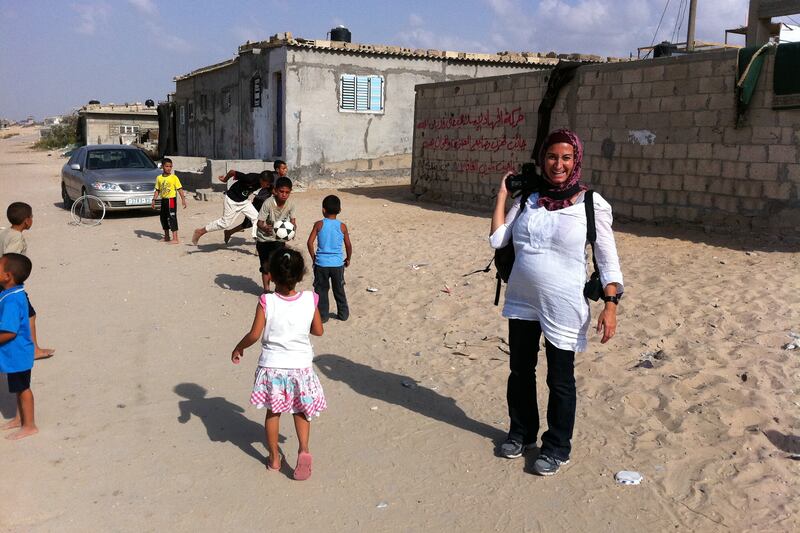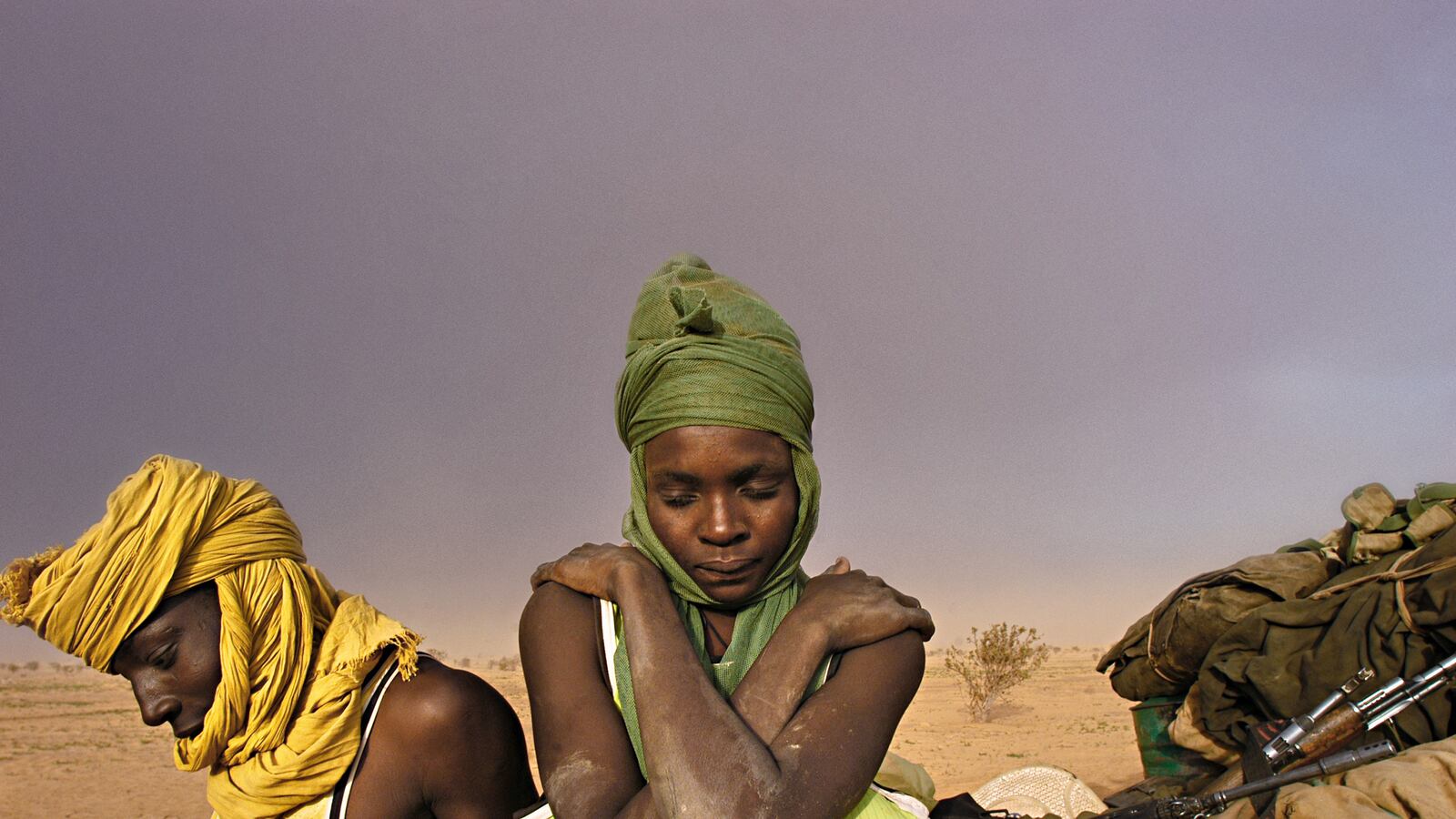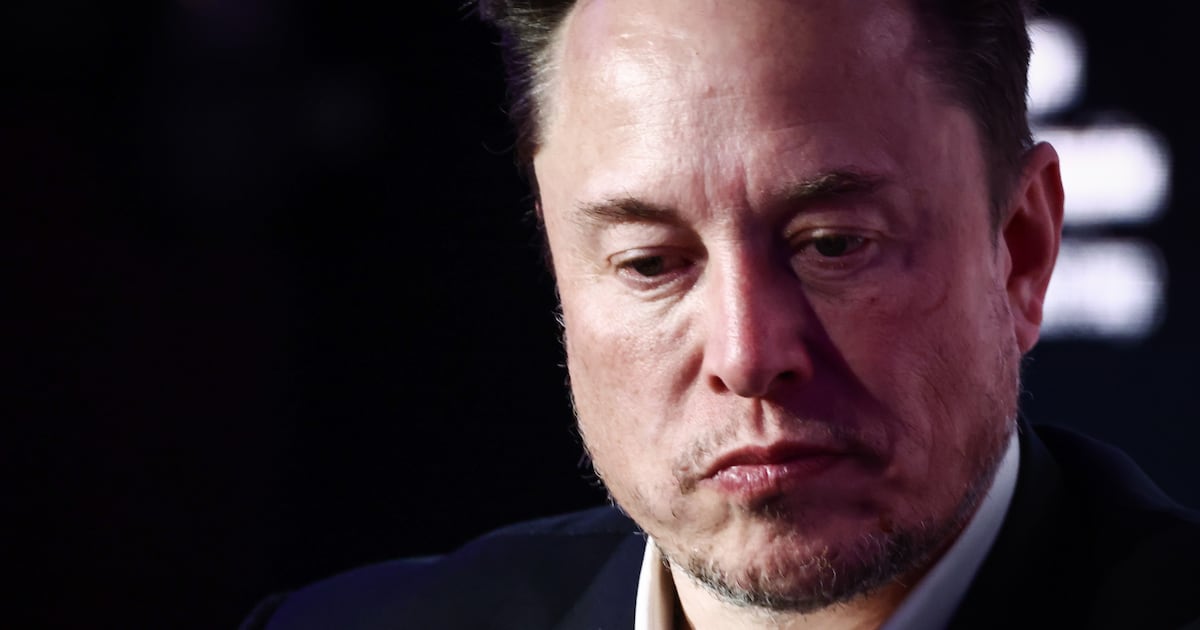Lynsey Addario is a hard woman to pin down.
Since the beginning of her career as a photojournalist in her early 20s when she decamped to Buenos Aires, she has been on the move. From Argentina, to Turkey, Iraq, Afghanistan, Libya, and Darfur (an incomplete list), she has grabbed a front-row view of history. The public is better off for it: her photographs have dominated the covers of The New York Times Magazine, the front page of the paper and in National Geographic, just to name a few.
Oh, and she’s been on a team that won the 2009 Pulitzer for international reporting, and she’s the recipient of the no-strings-attached MacArthur “Genius” Fellowship.
As if to underscore her peripatetic life, this interview had to be snatched in a 30-minute block from her 15-hour day of shooting while on assignment in Saudi Arabia for National Geographic.
The Daily Beast spent almost a week playing phone and email tag with Addario, sending subject lines like, “Can you call me now?” (We finally spoke on Wednesday at 11:30 p.m. Saudi time after Addario had put in a full day of shooting.)

It’s this life, rich in both experience and heartbreak, that Addario documents in her new book, It’s What I Do: A Photographer’s Life of Love and War. It opens with the harrowing kidnapping of the New York Times team in Libya as the country collapsed into chaos in 2009. Photographers Addario and Tyler Hicks, and writers Anthony Shadid and Stephen Farrell, were captured by forces loyal to Muammar Gaddafi and held for two weeks before they were finally released.
After their return to New York, Addario was approached about writing the book. It’s been a hit, and Warner Bros is reportedly finalizing a deal for Steve Spielberg to direct the movie, with Jennifer Lawrence starring. (Addario declined to talk about the movie, saying she hasn’t signed the contracts.)
The book outlines a success all her own, spanning years of fierce dedication to her work. Indeed, until Addario meets her husband, Paul, a fellow journalist in Istanbul, the men in her life tend to depend on her. It’s finally with Paul that she meets a partner who fully supports her work instead of tearing her away from it.
Sometimes, however, Addario overuses the emotional long lens that allows the reader to peer through into her life. Even intensely emotional events—her kidnapping in Libya, the death of friends, the news that she had just received a MacArthur Fellowship—are viewed from a remove. Yes, Addario is one of the best photographers in the business, who has touched hearts with her images, often of the victims of conflict, but there are times when the reader is left wanting more, as she seems to struggle with how best—or even whether—to express not only how these events impacted her personally but also professionally.
But when she does let us in close, the payoff is worth it. In one moving scene after she returns from covering the 173rd Airborne in Afghanistan in the Korengal Valley, she almost loses it at a dinner party Paul had arranged. A soldier she had befriended had been killed in a Taliban ambush and she herself came close to death. The innocent questions of her dining companions—“Was it dangerous? Have you ever almost died?”—were too much for her at that moment.
I could feel my chest tightening and my body getting hot. It was an unfamiliar feeling, being overcome with emotion in the middle of drinks with friends.
“Please excuse me for second,” I said. “I have to go to the restroom.”
I walked back to her bedroom in the rear of the apartment, closed the door behind me, and collapsed into tears. I pulled my cell phone out of my pocket and dialed [fellow New York Times reporter Elizabeth Rubin]’s number.
“Elizabeth?” I said, my voice wavering.
“I can’t stop crying,” she said.
“Me neither. Oh, God. And Paul has company here. I am locked in the bathroom and can’t stop crying.”
“You will be OK. You will be OK.”
We stayed on the phone until I stopped crying, and eventually I went back to my guests, finished my glass of wine and left for dinner along the Bosporus.
Those around her say this is vintage Addario: Deeply affected by what she sees, but also eager to move forward. As she said in our interview, “I’m not the kind of person to sit and dwell for ages on something that happened. I go through something, I experience it, I try to learn from it, and I move forward.”
Here’s more from The Daily Beast’s off-hours talk with Addario, edited for brevity.
How did the book come about?
After we were released from captivity in Libya, we went to New York, and several different literary agents reached out to me and asked me if I was interested in writing a book, because I’m a female war photographer and there weren’t many, and was I interested. And my initial inclination was no, because I just didn’t feel like something that happened two weeks out of my life was enough to merit writing a book, so I just didn’t feel like I was in that headspace.

I wanted to do a photo book, actually, at that point, because I felt I was finally ready to meet with Aperture, and at that point that’s when I found out Tim [Hetherington] and Chris [Hondros] had been killed. And I sort of backed up and really was thrown into a tailspin, and was trying to figure out why we had survived and they hadn’t.
And immediately, my visceral reaction was to back away from photography. And I thought maybe I will write a book. Because maybe this is how I want to express myself right now. And so, that’s how it came about.
And then someone put me in touch with Binky Urban, Amanda Urban, my literary agent, and we had a meeting and she was incredibly enthusiastic. And she’s a very big agent, and she just convinced me that I would write this amazing book and really sort of ushered me through the whole process. And eventually, Ann Godoff of Penguin gave me a book deal, and so that’s how it came about.

You and I have crossed paths two or three times, and I know that whenever I would come back home, especially during the Iraq War, or when I was in Pakistan, people would say, “But what’s the real story? I know you guys aren’t really telling us everything.” And given that we’ve lost so many: Tim Hetherington, Chris Hondros, Marla Ruzika, Anthony Shadid, just to name a few. Name after name. Given the risks we’ve all taken to tell stories, how do you deal with that inherent distrust that we’re toeing some kind of a line?
Well, I sort of explain that, in fact, we’re not and anyone who does this job is not earning a huge amount of money. We’re not leading the glamorous lives that people think we’re leading, and we’re also fighting to get access to the story we’re telling. So I think that it’s really important to actually explain that, and to explain that people are wrong. You know, for me, my response is actually just to explain how wrong they are because there’s no point in fighting with people who have no idea what they’re talking about.
I think some people may take issue when you said that you don’t lead a glamorous life, because based on your book—living in Istanbul, marrying a count [Paul is actually a Liechtensteinian count]… I mean you’ve had a relatively exciting, glamorous life.
Well, I mean, it certainly was not easy. Sure, I married a count, but I was 35 years old. I would say, relative to the women that I’ve photographed throughout my life, surely my life is glamorous. But I don’t think this job is glamorous. It entails trudging through the desert, staying in shitty hotel rooms, getting detained over and over by police and intelligence services from shady countries around the world. It’s not anything glamorous sometimes. I mean I’ve been out shooting for 15 straight hours. Glamorous?
One thing that came across in the book is your constant struggle to balance your ambition and your desire for emotional stability. Even now, is that still a challenge for you?
I do still struggle with that; I struggle with that all the time, and I think I also struggle with my ambition—well it’s not necessarily my ambition. I would say, generally, I’m not sure what I’m ambitious for. I would say it’s more my dedication rather than ambition. Yeah, I’m constantly struggling. You know, the stories that I feel like I could cover, do the work that I want to do and being a mother. That’s really where my struggle is—and being a wife and having a life—and for me it’s really hard to find that balance. I’m always struggling to find that balance.
You’ve had your share of challenges. Your parents split up, you’ve had to scrape by for years. You’re a woman in a traditionally male-dominated profession. How have you incorporated those challenges into your work, or have they informed your work?
First of all, every person I photograph affects my vision in some way and also affects how I interpret any situation because I’m constantly learning from the people that I photograph. I think, for me, personally, I try to be sensitive to issues as I learn about them. And I also try to constantly become not only a certain type of person but also become more in tune to the issues I’m covering. As I get older I think that things just affect me more.
And so I sort of move with a slower pace. I just try to tread a little lighter than I used to when I was in my 20s. Because I guess I’ve seen so much, and I’ve seen so many people die and I’ve seen so many women suffer and I try to figure out a way to tell their story in a unique way and in a sensitive way. And that’s hard to do when I’ve been covering these stories for many, many years now.
I’ve always seen you—and people that I know have always described you—as this tough-as-nails ball of energy. In the book, you really seem like you’re getting towards revealing a fair amount of vulnerability, but a lot of times you seem to pull back and then not quite go all the way, in terms of revealing yourself. When you were writing the book, was that a very difficult kind of process for you to go through?
No, actually, not at all. I just think there was a finite amount of space. And we decided we wanted to cover a certain amount of ground, and so rather than to go very profoundly in every single section where I felt vulnerable, we just moved forward, because I’m also not an incredibly introspective person. I think about things but then move forward. So, I’m not the kind of person to sit and dwell for ages on something that happened. I go through something, I experience it, I try to learn from it, and I move forward. And I think that’s how the book comes across. So, yeah, people have said, “We wish you had gone deeper, and spent more time...” But for me it was really about telling the story of the trajectory of my career and who I am and the people I’ve met along the way. And so, I didn’t really feel like I needed to go deeper into some places. But that is a totally valid criticism.
As a photojournalist, where do you see the industry going? Rates are going down through the cellar; Time magazine is buying Instagram stuff for the cover of their magazine. Where do you see the industry going with the democratization of photography, I guess you might say?
Yeah, that’s a very tough question. I think everyone’s asking themselves that question. For me personally, I’m constantly trying to really re-negotiate how I’m going to make a living, because I can’t make a living solely off editorial. And I’m also still trying to tell long feature stories that are harder and harder to get assigned, you know. National Geographic still gives me a fair amount of time on assignments. Very luckily The New York Times does as well, but I still need to supplement that with speaking engagements and doing other things. So I think photographers have to increasingly be more creative about how they make a living in order to tell the stories they want to tell.
And I think there are many different platforms now than there used to be. A lot of photographers are on Instagram all the time. I personally don’t post that much because I’m often on assignment and I can’t. It interferes, or I can’t really post what I’m shooting. But I think every photographer has their main venue to publish, whether it’s a publication or a social media site. There are many different platforms at this point and that is one of the benefits of being in the digital age. And while there aren’t that many paper publications, there are many platforms digitally.
Any advice for young photographers? Other than don’t go to Syria.
Yeah. Well, that’s a no-brainer. … I think people expect things to be handed to them very quickly after they graduate from photo school or wherever. You don’t get from Point A to Point B overnight. It takes a long time, long hours, and a lot of dedication. And you’re never in that comfort zone you might get in other professions. You know, after almost 20 years of shooting, I’m still worried about, “Will I get more assignments, what am I working on next?” And that doesn’t go away, you know you have to be hungry and you have to be dedicated and you have to love what you do.





